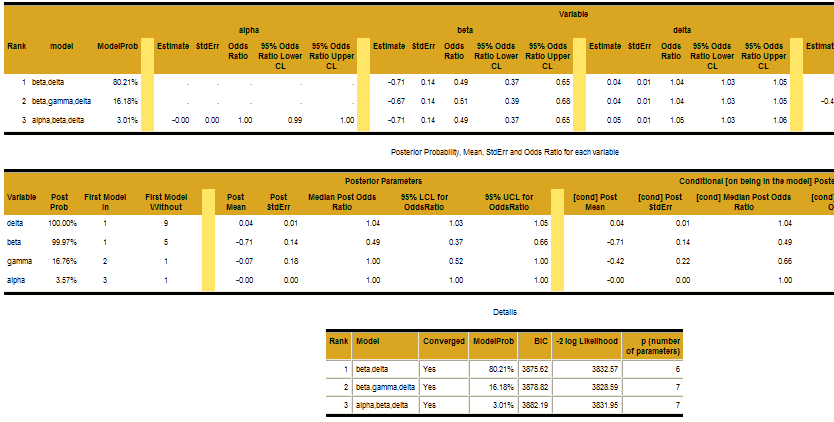|
Clinician's corner |
|
Back to main page |
|
Programmer's corner |
| So, you use WinBUGS a lot? Want more? |
|
Patrick Blisle Division of Clinical Epidemiology McGill University Health Center Montreal, Quebec CANADA patrick.belisle@rimuhc.ca Last modification: 24 sep 2015
|
|
|
Version 1.1 (July 2011)
SAS macro %BICOrdinalLogistic
Computing the BIC (Bayesian Information Criterion) in Ordinal Logistic Regression Models
Model selection for (dichotomous) logistic regession models is made easy in R
through the use of Chris Volinsky's bic.glm function.
However, this function does not accommodate ordinal outcomes.
When the outcome variable is ordinal,
there is to my knowledge no R or SAS function or macro available, hence the need for %BICOrdinalLogistic.
| [ | %BICOrdinalLogistic is a SAS macro for computing Bayesian Information Criterion (BIC) in Ordinal Logistic Regression Models. | ] |
Unlike the BIC functions available for R which use Occam's Razor to pare down the total number of models reported, %BICOrdinalLogistic fits every possible model (i.e., 2p models for p covariates) derived from the list of independent variables (see indep in argument's list below). This means that %BICOrdinalLogistic may run for a long time — or may even crash — when the number of independent variables is large.
%BICOrdinalLogistic is a SAS macro included in the downloadable file that reports %BICOrdinalLogistic output in a reader-friendly fashion. See example below for an illustration of combined use of these two macros.
Menu
Top
Syntax
%BICOrdinalLogistic(outModels=, outParms=, data=, outcome=, indep=, force=, level=0.95);
Top
%BICOrdinalLogistic arguments list
| Argument | Value |
| outModels | Name of output dataset where the list of compared models will be saved. |
| outParms | Name of output dataset where each model's parameter estimates will be saved. |
| data | Name of the data set to be analyzed. |
| outcome | Name of the outcome variable. |
| indep |
List of independent variables.
String variables and formatted variables (variables with value labels) are analyzed as class variables. |
| force | An optional list of independent variables to be forced in the model (models without any of the variables listed will be discarded). |
| level | Level of Odds Ratio Credible Intervals reported. |
Top
Example
Consider the problem where the 5-category outcome variable Y is modeled through a series of four candidate variables, namely alpha, beta, gamma and delta, stored in data set myData. BIC model selection is run through the SAS macro call:
%BICOrdinalLogistic(outModels=bicModels, outParms=bicParms, data=myData, outcome=Y, indep=alpha beta gamma delta);
where the arguments bicModels and bicParms are output data sets, which can be printed, used or modified if necessary:
proc print data=bicModels; run;
Is
minus2log Null
Obs Model Converged BIC L p Model
1 NULL 1 3948.58 3919.88 4 1
2 delta 1 3893.04 3857.16 5 0
3 gamma 1 3949.17 3913.29 5 0
4 gamma,delta 1 3892.68 3849.62 6 0
5 beta 1 3940.16 3904.28 5 0
6 beta,delta 1 3875.62 3832.57 6 0
7 beta,gamma 1 3943.49 3900.43 6 0
8 beta,gamma,delta 1 3878.82 3828.59 7 0
9 alpha 1 3946.89 3911.01 5 0
10 alpha,delta 1 3899.33 3856.28 6 0
11 alpha,gamma 1 3946.39 3903.33 6 0
12 alpha,gamma,delta 1 3899.27 3849.03 7 0
13 alpha,beta 1 3936.14 3893.08 6 0
14 alpha,beta,delta 1 3882.19 3831.95 7 0
15 alpha,beta,gamma 1 3938.71 3888.48 7 0
16 alpha,beta,gamma,delta 1 3885.56 3828.15 8 0
Note that while running, %BICOrdinalLogistic prints proc logistic output (for each of the 16 models) to Sas output window: however, every relevant piece of information for the computation of BIC values is stored in the output data sets, and the output window can thus be ignored.
The sas macro %BICOrdinalLogistic (included in the downloadable file below) conveniently produces a comprehensive HTML version of the BIC output.
ods listing close;
ods html file="c:\users\pbelisle\My Documents\Home\MyProject\log\BICOrdinalLogistic.html" style=mystyle;
title 'BIC (Bayesian Information Criterion) results';
%BICOrdinalLogisticReport(parms=bicParms, models=bicModels);
ods html close;
title;
ods listing;
ods html file="c:\users\pbelisle\My Documents\Home\MyProject\log\BICOrdinalLogistic.html" style=mystyle;
title 'BIC (Bayesian Information Criterion) results';
%BICOrdinalLogisticReport(parms=bicParms, models=bicModels);
ods html close;
title;
ods listing;
which should look like this:
 |
| Click on the above image to view the actual Html output file. |
Note that only 3 (of the 16 possible models) were included in the report, since by default only the models with probability ≥ 1% are printed; to include all models in the report, call %BICOrdinalLogistic with the inclusive option where= (left empty), as in:
%BICOrdinalLogisticReport(parms=bicParms, models=bicModels, where=);
Top
Interaction terms
Interaction terms of order 2 are allowed in the model. Class variables, however, are not allowed to have interaction terms in the actual version.
%BICOrdinalLogistic(outModels=bicModels, outParms=bicParms, data=myData, outcome=Y, indep=alpha beta gamma delta alpha*gamma);
Top
Download
%BICOrdinalLogistic is a free SAS macro. Download version 1.1 now.